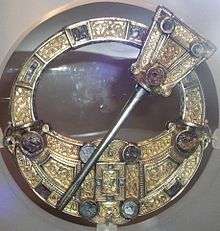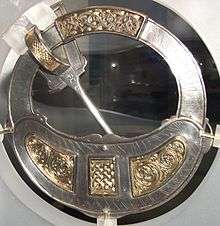Hunterston Brooch



The Hunterston Brooch is a highly important Celtic brooch of "pseudo-penannular" type found near Hunterston, North Ayrshire, Scotland, in either, according to one account, 1826 by two men from West Kilbride, who were digging drains at the foot of Goldenberry Hill,[1] or in 1830.[2] It is now in the National Museum of Scotland, Edinburgh. Made within a few decades of 700 AD,[3] the Hunterston Brooch is cast in silver, gilt, and set with pieces of amber (most now missing), and decorated with interlaced animal bodies in gold filigree.[3] The diameter of the ring is 12.2 cm, and in its centre there is a cross and a golden Glory representing the Risen Christ, surrounded by tiny bird heads. The pin, which is broken, can travel freely around the ring as far as the terminals, which was necessary for fastening; it is now 13.1 cm long, but was probably originally 15 cm or more.[4]
The brooch may have been made at a royal site, such as Dunadd in Argyll,[3] though is more likely to have been made in Ireland, especially as its pseudo-penannular form is typical of Irish brooches, whereas the truly penannular form remained usual in Pictish brooches.[4] On the other hand, its style is closely comparable to a terminal fragment of a penannular brooch found in Dunbeath in 1860 which probably was made in Scotland; craftsmen may have travelled across the area using the locally popular forms.[5] Lloyd and Jennifer Laing feel it was probably made in Dalriada, and the Museum of Scotland say "The style of the brooch has Irish parallels, while the filigree resembles metalwork from England. The brooch was probably made in western Scotland where the two traditions were joined, or perhaps in Ireland by a craftsman trained in foreign techniques."[6]
The brooch has a complex construction typical of the most elaborate Irish brooches. Panels of filigree work were created separately on gold trays, which were then fitted into the main silver-gilt body. On the reverse four panels of silver-gilt were also inserted; as in other examples like the Tara Brooch the decoration on the reverse uses older curvilinear "Celtic" motifs looking back to La Tène style Insular Celtic decoration, though on the Hunterston Brooch such motifs also appear on the front.[4]
The back of the brooch has a scratched inscription in runes in the Old Norse language, probably 10th century, "Melbrigda owns this brooch"; Maél Brigda, "devotee of Bridgit" is a common Gaelic female name, though seen as male by other sources.[7] Much later ownership inscriptions are not uncommon on elaborate Celtic brooches, often from Norse-Gael contexts. The Hunterston Brooch is clearly an object of very high status, indicating the power and great prestige of its owner. With the Tara Brooch in Dublin, and the Londesborough Brooch in the British Museum, it is considered one of the finest of over 50 highly elaborate Irish Celtic brooches to survive,[8] and is "arguably the earliest of the ornate penannular brooches from Britain and Ireland".[9]
Notes
| Wikimedia Commons has media related to Hunterston Brooch. |
References
- Lamb, Rev. John, BD, Annals of an Ayrshire Parish - West Kilbride, 1896, John J. Rae, Glasgow
- "Laings", Lloyd Laing and Jennifer Laing. Art of the Celts: From 700 BC to the Celtic Revival, 1992, Thames & Hudson (World of Art), ISBN 0-500-20256-7
- "NMS"; Hunterston Brooch National Museums of Scotland
- Whitfield, Niamh (2001), The "Tara" Brooch, in Hourihane, Colum (ed), From Ireland coming: Irish art from the early Christian to the late Gothic period and its European context, Princeton University Press, 2001, ISBN 0-691-08825-X, 9780691088259
- Susan Youngs (ed), "The Work of Angels", Masterpieces of Celtic Metalwork, 6th-9th centuries AD, 1989, British Museum Press, London, ISBN 0-7141-0554-6
External links
- Hunterston Brooch, National Museums of Scotland web feature
- Detailed photos of and information on the Brooch